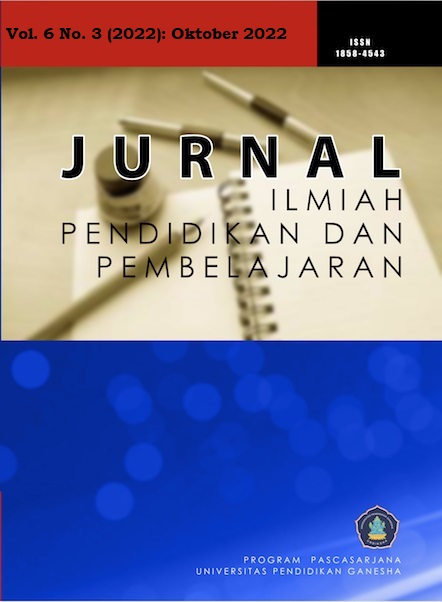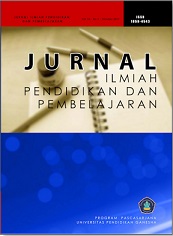Teaching Strategies for Children with Expressive Language Disorder
DOI:
https://doi.org/10.23887/jipp.v6i3.57791Keywords:
Teaching Strategies, children, Expressive Language DisorderAbstract
Students who have communication disorders will need special help from teachers in the regular education environments. This research aims to investigate the English teaching strategies and activities for students with language impairment, especially expressive language disorder. This research used descriptive qualitative research design which focus on literature study from relevance references. The collected data were analysed descriptively, thus the English teaching strategies and classroom management for students with expressive language disorder could be formulated. The result of the study showed that teaching strategies that could improve expressive language are Modelling, Expansion, Choices, Waiting or Withholding, Imitation, Parallel Talk, Picture Communication, Paraphrase, and Place Things Out of the Child’s Reach. Meanwhile, the activities that is suitable to be applied for students with expressive language disorder during instruction through which those activities are also applicable at home practice; wordless books, books with simple text, bubbles, play dough, toy animals, trains sets or car, and play food. Therefore, by implementing those strategies and activities, it is expected the students with expressive language disorder could improve their language competency either in receptive or productive use.
References
Arnold, S., & Reed, P. (2019). Measuring the word recognition abilities of children who are both verbal and nonverbal with ASD using a traditional paper-based and a novel digital test format. British Journal of Special Education. https://doi.org/10.1111/1467-8578.12279.
Ashman, G., & Snow, P. (2019). Oral Language Competence: How It Relates to Classroom Behavior. American Educator, 43(2), 37–41. https://eric.ed.gov/?id=EJ1218776.
Birgisdottir, F., Gestsdottir, S., & Geldhof, G. J. (2020). Early predictors of first and fourth grade reading and math: The role of self-regulation and early literacy skills. Early Childhood Research Quarterly, 53, 507–519. https://doi.org/10.1016/j.ecresq.2020.05.001.
Drager, K. D., Postal, V. J., Carrolus, L., Castellano, M., Gagliano, C., & Glynn, J. (2006). The effect of aided language modeling on symbol comprehension and production in 2 preschoolers with autism. AJSLP, 15(2), 112–125. https://doi.org/10.1044/1058-0360(2006/012).
Dunst, C. J., Trivette, C. M., & Raab, M. (2014). Everyday child language learning early intervention practices. Infants and Young Children, 27(3), 207–219. https://doi.org/10.1097/IYC.0000000000000015.
Elmahallawi, T. H., & Gabr, T. A. (2021). Children with developmental language disorder : a frequency following response in the noise study ଝ , ଝଝ. Brazilian Journal of Otorhinolaryngology, xxxx. https://doi.org/10.1016/j.bjorl.2021.01.008.
Faruq, Sabani, N., Sukarno, A., & Purwandari, E. (2021). Systematic Literature Review: Psychological Concepts Of Learning In Handling Speaking Delay In Early Children. Jurnal Penelitian Humaniora, 23(1), 45–54. https://doi.org/10.23917/humaniora.v23i1.19126.
Fitriyani, F., Sumantri, M. S., & Supena, A. (2019). Language development and social emotions in children with speech delay: case study of 9 year olds in elementary school. Jurnal Konseling Dan Pendidikan, 7(1), 23. https://doi.org/10.29210/130600
Fox, A. V., Dodd, B., & Howard, D. (2002). Risk factors for speech disorders in children. International Journal of Language and Communication Disorders, 37(2), 117–131. https://doi.org/10.1080/13682820110116776.
Gillam, S. L. (2017). Language Disorder in Children Running Head : LANGUAGE DISORDER Language Disorder in Children Sarai Holbrook Carla Orellana Utah State University In S . Goldstein & M . DeVries ( Eds .), Handbook of DSM-5 Disorders in Children and (Issue January). https://doi.org/10.1007/978-3-319-57196-6.
Grady, W. O. (2006). The Problem of Verbal Inflection in Second Language Acquisition. In Proceedings of the Conference of the Pan-Pacific Association of Applied Linguistics, 169–190. http://www.ling.hawaii.edu/faculty/ogrady/Verbal_inflection_in_SLA.pdf.
Hambly, C., & Fombonne, E. (2012). The impact of bilingual environments on language development in children with autism spectrum disorders. Journal of Autism and Developmental Disorders, 42(7), 1342–1352. https://link.springer.com/article/10.1007/s10803-011-1365-z.
Indah, R. N. (2017). Gangguan Berbahasa: Kajian Pengantar. In Uin-Maliki Press (Vol. 15, Issue 3). http://repository.uin-malang.ac.id/1296/.
Indrayani, N. (2016). Language development at early childhood. In International Conference on Education (IECO), 279–289. http://jurnal.unmuhjember.ac.id/index.php/IECO/article/download/522/406.
Kiogora, N. (2021). Children with speech and language disorders. International Academic Journal of Arts and Humanities, 1(2), 360–376. https://iajournals.org/articles/iajah_v1_i2_360_376.pdf.
LeBarton, E. S., Iverson, J. M., LeBarton, E. S., & Iverson, J. M. (2013). Fine motor skill predicts expressive language in infant siblings of children with autism. Developmental Science, 16(6), 815–827. https://doi.org/10.1111/desc.12069.
Lee, J. A. C., Lee, S., Yusoff, N. F. M., Ong, P. H., Nordin, Z. S., & Winskel, H. (2020). An Early Reading Assessment Battery for Multilingual Learners in Malaysia. Frontiers in Psychology, 11. https://doi.org/10.3389/fpsyg.2020.01700.
Levia, R., Jufrizal, J., & Marlina, L. (2019). The Study Of Language Disorder Of An Autistic Savant Portrayed In Levinson ’ S Rain Man Film ( 1988 ). English Language and Literature, 8(1). https://doi.org/10.24036/ell.v8i1.103059.
Licata-Dandel, M., Wenzel, A. S., Kristen-Antonow, S., & Sodian, | Beate. (2021). Predicting child problem behaviour at school age: The role of maternal sensitivity, child temperament and theory of mind. https://doi.org/10.1002/icd.2264.
Lisa, R., Pola, R., Franz, P., & Jessica, M. (2019). Developmental language disorder: Maternal stress level and behavioural difficulties of children with expressive and mixed receptive-expressive DLD. Journal of Communication Disorders, 80(March), 1–10. https://doi.org/10.1016/j.jcomdis.2019.03.006.
Nimehchisalem, V., & Bhatti, N. (2019). A Review of Literature on Language Assessment Literacy in last two decades (1999-2018). International Journal of Innovation, Creativity and Change, 8(11). www.ijicc.net
Paul, R., Norbury, C., & Gosse, C. (2018). Assessing students’ language for learning. Language Disorders from Infancy Through Adolescence, 440–502. https://doi.org/10.1016/b978-0-323-44234-3.00020-8.
Phillips, B. M., Kim, Y. S. G., Lonigan, C. J., Connor, C. M., Clancy, J., & Al Otaiba, S. (2021). Supporting language and literacy development with intensive small-group interventions: An early childhood efficacy study. Early Childhood Research Quarterly, 57, 75–88. https://doi.org/10.1016/j.ecresq.2021.05.004.
Pierson, R. F. (2020). Strategies for Building Language and Communication Skills in Children. 58.
Pransiska, R. (2017). Benefits of Bilingualism in Early Childhood: A Booster of Teaching English to Young Learners. January 2017. https://doi.org/10.2991/icece-16.2017.68.
Riduwan. (2008). Method and Teknik Menyusun Thesis. Bandung: Alfabeta.
Rosmala, D., Hidayati, A. N., & Abdullah, F. (2021). Early Language Development ofaChildwithExpressive Language Disorder:A Parents’ Narration. J-SHMIC: Journal of English for Academic, 8(1), 86–96. https://doi.org/10.25299/jshmic.2021.vol8(1).6305.
Sandra, L. A., & Kurniawati, L. A. (2020). Differentiated instructions in teaching English for students with autism spectrum disorder. Jet Adi Buana, 5(01), 41–53. https://doi.org/10.36456/jet.v5.n01.2020.2274.
Schick, A. (2015). Wordless book-sharing styles in bilingual preschool classrooms and Latino children’s emergent literacy skills. Journal of Early Childhood Literacy, 15(3), 331–363. https://doi.org/10.1177/1468798414551942.
Sheppard, E., Lalancette, E., Thébault-Dagher, F., Lafontaine, M. P., Knoth, I. S., Gravel, J., & Lippé, S. (2021). Cognitive and behavioural development in children presenting with complex febrile seizures: at onset and school age. Epileptic Disorders, 23(2), 325–336. https://doi.org/10.1684/EPD.2021.1260.
Sproston, K., Sedgewick, F., & Crane, L. (2017). Autistic girls and school exclusion: Perspectives of students and their parents. Autism and Developmental Language Impairments, 2. https://doi.org/10.1177/2396941517706172.
Torres, F., Fuentes-López, E., Fuente, A., & Sevilla, F. (2020). Identification of the factors associated with the severity of the speech production problems in children with comorbid speech sound disorder and developmental language disorder. Journal of Communication Disorders, 88(June 2019). https://doi.org/10.1016/j.jcomdis.2020.106054.
Van Lith, T., Quintero, A., Johns, S., & Grzywacz, J. G. (2021). Promoting kindergarten readiness using early intervention art therapy with Latinx farmworker children. The Arts in Psychotherapy, 73, 101753. https://doi.org/10.1016/j.aip.2020.101753.
Vishkaie, R. S., & Levy, R. M. (2015). Bubble Play: An Interactive Learning Medium for Young Children. International Conference on Cyberworlds (CW), 286–293. https://doi.org/10.1109/CW.2015.23.
Wildová, R., & Kropáčková, J. (2015). Early Childhood Pre-reading Literacy Development. Procedia - Social and Behavioral Sciences, 191, 878–883. https://doi.org/10.1016/j.sbspro.2015.04.418.
Wolfe, D. L., & Heilmann, J. (2010). Simplified and expanded input in a focused stimulation program for a child with expressive language delay (ELD). Child Language Teaching and Therapy, 26(3), 335–346. https://doi.org/10.1177/0265659010369286.
Yuniari, N. M., Ayu, I. G., & Triana, I. (2020). Strategi Terapis Wicara yang dapat Diterapkan oleh Orang Tua Penderita Keterlambatan Berbicara (Speech Delay). Jurnal Ilmiah Pendidikan Dan Pembelajaran, 4(3), 564–570. https://doi.org/10.23887/jipp.v4i3.29190.
Downloads
Published
How to Cite
Issue
Section
License
Copyright (c) 2023 Ni Made Yuniari, I Putu Yudi Sudarmawan

This work is licensed under a Creative Commons Attribution-ShareAlike 4.0 International License.
Authors who publish with the Jurnal Ilmiah Pendidikan dan Pembelajaran (JIPP) agree to the following terms:
- Authors retain copyright and grant the journal the right of first publication with the work simultaneously licensed under a Creative Commons Attribution License (CC BY-SA 4.0) that allows others to share the work with an acknowledgment of the work's authorship and initial publication in this journal.
- Authors are able to enter into separate, additional contractual arrangements for the non-exclusive distribution of the journal's published version of the work (e.g., post it to an institutional repository or publish it in a book), with an acknowledgment of its initial publication in this journal.
- Authors are permitted and encouraged to post their work online (e.g., in institutional repositories or on their website) prior to and during the submission process, as it can lead to productive exchanges, as well as earlier and greater citation of published work. (See The Effect of Open Access)










